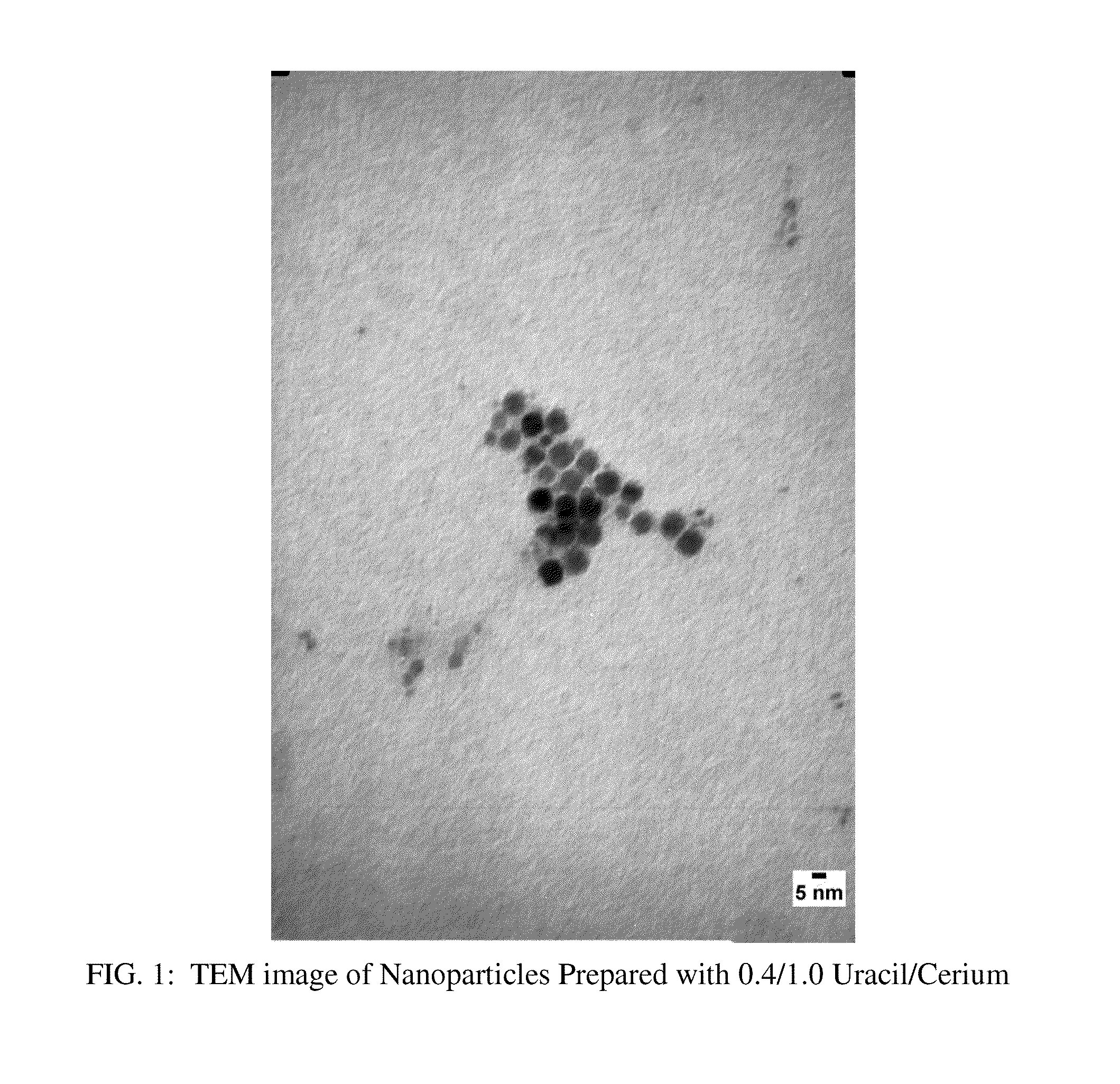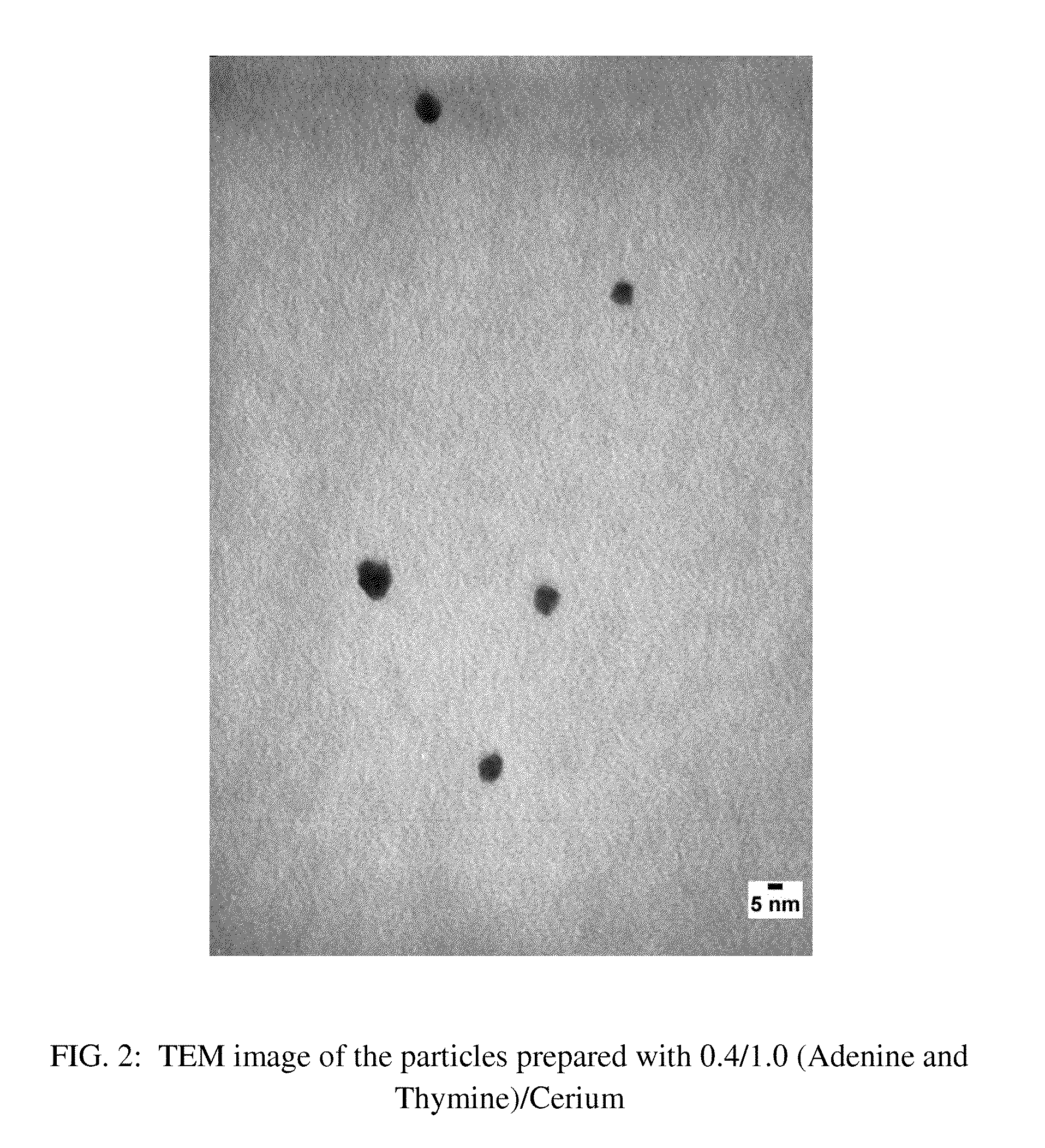Nanoparticles of a metal and a nucleobase
a technology of nanoparticles and nucleobases, applied in the field of nanoparticles of metals and nucleobases, can solve the problems of toxic response, reduced efficacy and deliverability, and higher than desired toxicity to mammalian cells
- Summary
- Abstract
- Description
- Claims
- Application Information
AI Technical Summary
Benefits of technology
Problems solved by technology
Method used
Image
Examples
example 1a
0.4 Molar Ratio of Adenine to Cerium
[0087]Into a 400 mL glass beaker containing a magnetic stir bar, 250 mL of high purity (HP) water was introduced, and then 0.629 g of 99% adenine was added with stirring and gradual heating to 40° C. until dissolved. A 5.0 g quantity of Ce(NO3)3.6H2O dissolved in 20 mL HP water was then added to the reaction mixture, resulting in a solution pH of 5.96. Then, a 0.24 g quantity of 50% H2O2 was diluted into 10 mL of HP water and added to the reaction mixture, which immediately turned an amber red color with a pH of 3.61. After a few minutes of stifling, the reaction mixture turned a translucent tangerine orange color. The reaction mixture was held at 40° C. for 1 hour, and then cooled with stirring overnight, thereby forming a product dispersion at a final pH of 4.55. Particle size analysis by DLS revealed a hydrodynamic particle size of 16.6 nm with a polydispersity of 0.191, indicating that a stable dispersion of nanoparticles had formed.
[0088]The ...
example 1b
0.4 Molar Ratio of Adenine to Cerium (Washed)
[0089]The procedures of Example 1a were repeated, whereby a product dispersion at a final pH of 4.02 was formed. The product dispersion was then washed by a diafiltration process maintained at a constant volume by addition of about one turnover of HP water, and then concentrated to a final volume of about 100 mL.
[0090]Particle size analysis by DLS on the washed / concentrated product dispersion indicated a hydrodynamic diameter of 16.95 nm with a polydispersity of 0.191.
example 1c
0.6 Molar Ratio of Adenine to Cerium (Washed)
[0091]The procedures of Example 1b were repeated except that the amount of adenine was increased to 0.943 g (0.6 molar ratio of adenine to cerium). Following cooling of the reaction mixture, a final pH of 3.85 was obtained. The product dispersion was then washed by a diafiltration process maintained at a constant volume by addition of about one turnover of HP water, and then concentrated to a final volume of about 100 mL.
[0092]Particle size analysis by DLS on an aliquot of the washed / concentrated product dispersion indicated a hydrodynamic diameter of 16.5 nm with a polydispersity of 0.166.
Preparation of Nanoparticles with Cerium and Caffeine
PUM
| Property | Measurement | Unit |
|---|---|---|
| temperature | aaaaa | aaaaa |
| particle size | aaaaa | aaaaa |
| size | aaaaa | aaaaa |
Abstract
Description
Claims
Application Information
 Login to View More
Login to View More - R&D
- Intellectual Property
- Life Sciences
- Materials
- Tech Scout
- Unparalleled Data Quality
- Higher Quality Content
- 60% Fewer Hallucinations
Browse by: Latest US Patents, China's latest patents, Technical Efficacy Thesaurus, Application Domain, Technology Topic, Popular Technical Reports.
© 2025 PatSnap. All rights reserved.Legal|Privacy policy|Modern Slavery Act Transparency Statement|Sitemap|About US| Contact US: help@patsnap.com


